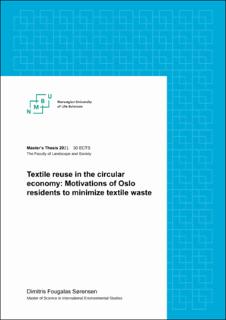| dc.description.abstract | Norway is subjected to environmental changes that are affecting a sustainable future for the generations to come. This situation is further proliferated as per the ongoing global economic trends. The economy and environment have a direct relationship implying that more economic development would cause environmental pollution. After the EU initiated its environmental policy and initiatives, Norway also took the responsibility of a circular economy, coupled with saving the environment. Concerning this, the textile industry is involved in releasing toxins, chemicals, and harmful substances from the dyes and materials used during the production process. Hence, a sustainable transition in the textile industry is an immediate requirement of Norway. The prevalent neoliberal economy suggests that production and consumption are motivated by the demand and supply forces in an economy, leading towards excessive waste. However, a circular economy encourages reuse and recycling along with the production and consumption practices in the economy. This study examines the motivating factors in Oslo residents that promote textile waste reduction by buying and selling second-hand clothes. In doing so, this study conducted 10 online semi-structured interviews. Through a series of exploratory, descriptive, and explanatory question, the interviews investigated user discussion, motivation, and behavior. The data collected from these interviews went through data analysis techniques which helped identify five patterns, namely, "Environmental and Social Justice Concerns", "Economic Motivations", "Belief in Reuse", "Identity and Style", and lastly "Doing What is Right". Data analysis was done by applying the Value-Belief-Norm (VBN) theory, and concepts including Reduce, Reuse, and Recycle (3R) and waste hierarchy. Furthermore, the study has discussed the importance and significance of Norwegian policies regarding reuse and recycling that falls under the EU environment policy and framework. Lastly, another significant deduction from the analysis is the need to raise awareness towards the authorities to successfully implement an environment-friendly policy within a circular economy. | en_US |

